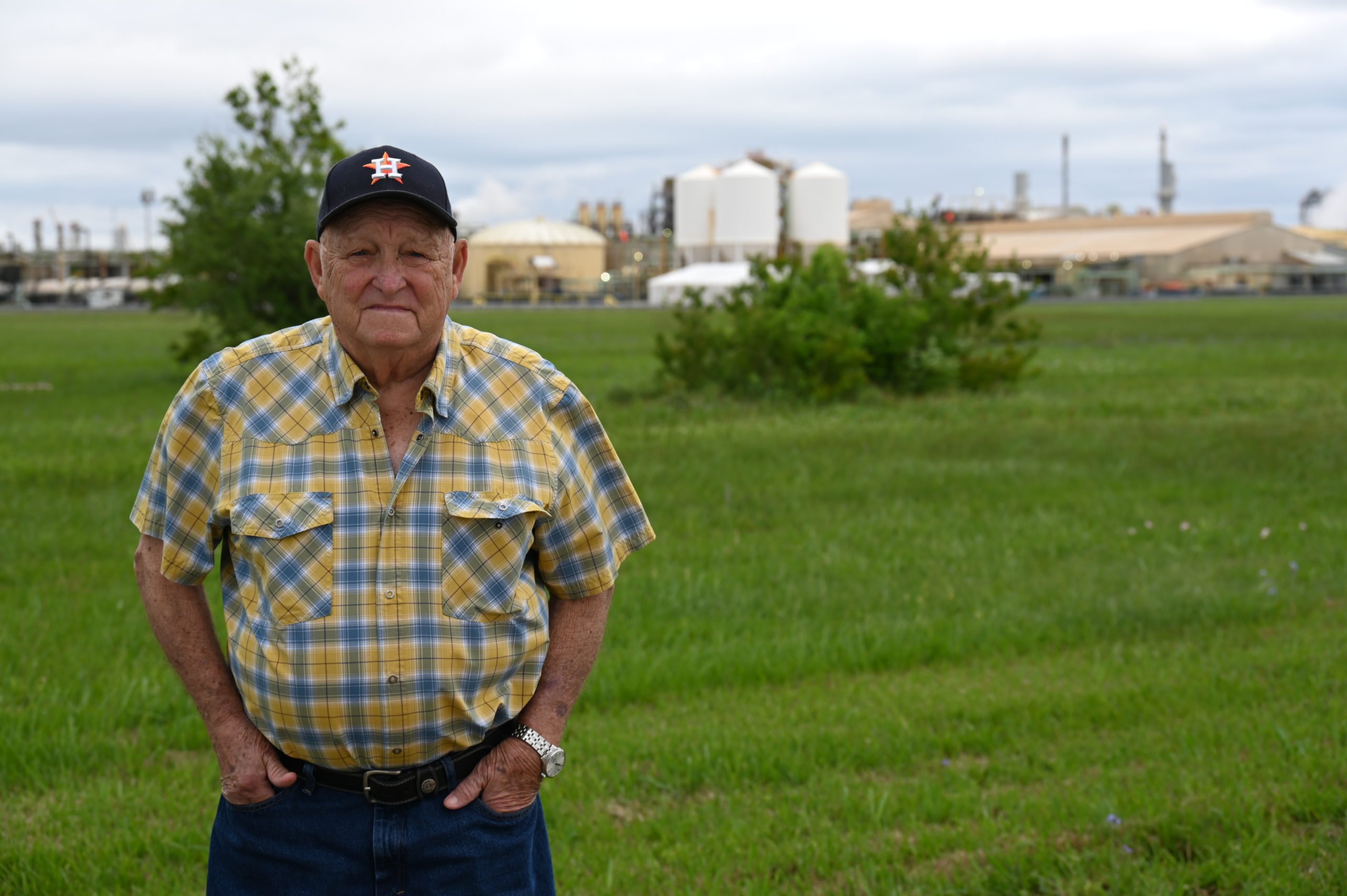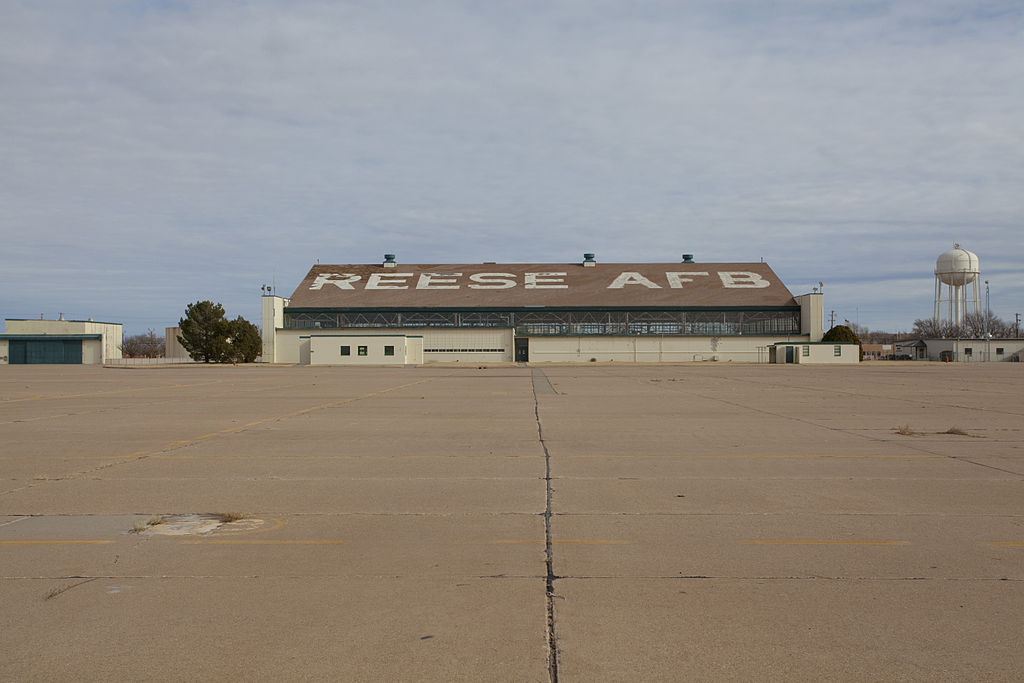
Battleground Plant
In Deer Park and other chemical corridor communities, the slow seepage of toxics can affect families like mine for generations.
Above: The author's grandfather, Sam Allen, in front of a power plant in Deer Park, Texas.
This story is from the July/August 2021 issue.
Sam Allen almost always hitched a ride to work with his best friend Floyd. The plant was only a 10-minute drive from his Deer Park home across Texas Highway 225, but he liked to save on gas.
Theirs was the graveyard shift, starting after supper and running until 6 a.m. The smell of sulfur hung in the air as they approached the chemical complex. A chorus of cicadas hummed from beyond the parking lot fence as Sam strapped on his hard hat and respirator. Above, a canopy of metal pipes bloomed in all directions; within them, deadly substances raced.
Sam, my grandfather, worked as an operator for most of his nearly four-decade career. He started in 1959 at Diamond Shamrock, one of many hulking beasts that inhabited Deer Park’s petrochemical peninsula. Shell, Lubrizol, and Dow Chemical facilities, among others, formed a skyline of smokestacks and storage facilities that curved along the Houston Ship Channel.
Diamond Shamrock, which Sam called the Battleground Plant, specialized in chlorine production. Across the plant, men applied freezing temperatures and searing acid baths until the chlorine submitted to its more docile, deoxygenated liquid form. Sam sat in front of a 10-foot control board of blinking monitors and switches, charged with guiding the chemical through a maze of industrial towers. Engines roared and pipe valves shuddered, rattling metal and eardrums alike.
And leaks, well, they were inevitable.
Deer Park and the surrounding Pasadena area, about 20 miles east of Houston, usually appear in news headlines on the coattails of disaster. Deadly blasts and raging chemical fires are not unusual: A 1989 explosion at Phillips Petroleum killed 23 employees and injured another 314. In 2014, four workers at the nearby DuPont facility died after toxic gases escaped from a faulty valve. Five years later, an Intercontinental Terminals Company storage terminal caught fire, releasing 20 million pounds of contaminated water into the ship channel and blackening the sky all the way to downtown Houston.
But between those moments of chemical carnage, the slow seepage of toxics in Deer Park continues. In Sam’s time, leaks were usually small enough to be sealed off before any alarms were triggered. If you didn’t work there, you probably didn’t hear about it.
Sam didn’t like to bring his work home with him. My grandmother, his wife, had a vague idea of the dangers, but she “didn’t want to know about it, and I wanted to forget about it,” he tells me. “There were times you get concerned about it, whenever some of your co-workers died with cancer,” he says, his voice catching with emotion. But Sam had to believe that those industrial compounds would stay where they were supposed to: outside his body and inside the facility’s fence line.
Floyd wasn’t so lucky. He’d seemed fine when Sam left for a family road trip one summer; still in his early 50s, Floyd had hid his fight with lung cancer well. But his body suddenly started to fail a week into Sam’s vacation. Floyd was buried before my grandfather got back.
*
My mother, Laura, started high school in Deer Park in 1984. It was still a small, working-class community, but you wouldn’t have known it from the look of her campus. According to a newspaper clipping from the time, the school district was “blessed” with enough industry tax revenue to afford a professional-grade football stadium and fetal pigs and cats for the biology students.
Diamond Shamrock had its own clubhouse—my mother and grandfather swore it was the nicest place in town. Sam and other employees had built it themselves with company funding; tucked right inside the plant’s fence, its raised dance floors were home to many honky-tonk nights and Christmas parties. When the summer heat became scorching, they found refuge in the clubhouse pool. As Laura floated, Sam would grill hot dogs as gray plumes sputtered from smokestacks above. Whether their sinuses burned from chlorinated air or water, they weren’t sure.
Every so often, an alarm would sound, indicating that something, somewhere, had leaked. Some families retreated into the clubhouse until the air had cleared of the unidentified particulate matter, but most simply carried on with their picnics. “Honestly, I didn’t really think that much about whether there was any danger,” Laura remembers. “It was just normal.”
When I ask my grandfather how many of his co-workers died during his time in Deer Park, he says he doesn’t know. He remembers cases of liver cancer, lung cancer, and more. “Who knows, maybe they didn’t wear their mask all the time,” he says, with a shrug. “I couldn’t even say that [the chemicals] caused the cancer, ’cause I don’t know. But when you work around all those chemicals, and you breathe a lot of it, it’s not good.”
To outsiders, including myself, my relatives’ ambivalence towards their chemical environment may seem strange, even absurd. It wasn’t until I began to study the issue as an environmental sociology student that I learned that this confusion is not a fluke.
Of course, there is an economic incentive to ignore the threat of leakage: Wages from the petrochemical plants put food on the table. But Javier Auyero, professor of Latin American Sociology at the University of Texas, and Débora Swistun, an environmental sociologist in Buenos Aires, propose a thornier explanation. Their research examines Flammable, an aptly named Argentinian shantytown mired in the waste of the country’s largest petrochemical facility. Much like in Deer Park, residents’ concern about pollution there was frayed with doubt and denial, the researchers found. They named the phenomenon “toxic uncertainty.”
“We find security in what is familiar to us, in what we can get a hold on,” they wrote in their 2008 book. When it comes to living among industrial contamination, “routines help us screen out, or at least suspend the thought of, the unpleasant.”
Closer to home, in Louisiana’s Cancer Alley, medical anthropologist Merrill Singer took up this line of inquiry. “Individuals who experience toxic frustration feel reasonably certain that their environment is unhealthy,” he wrote in 2011. But “on a day-to-day basis, they usually avoid thinking about these issues too much unless they are prompted by specific events. … Rather, they usually go on with their lives and hope…that things will be okay or even improve.
*
Unlike Floyd and unknown numbers of other co-workers, my grandfather made it out of Deer Park alive. He retired in 1997 after 40 years working in chemical refineries, leaving Deer Park for the wooded suburbs of Conroe. “I didn’t want to be around those smells and chemicals no longer than I had to,” he says.
My mother moved to Houston, raising my sister and me just beyond the sound of industrial sirens. Despite living only 23 miles away, we never visited Deer Park. It was only as I began to study chemical environments in college that my questions about our family began to coalesce. With some convincing, my grandfather and mother agreed to return to Deer Park this spring—a pilgrimage of sorts, three generations retracing their exodus from an unholy site.

We pulled off Highway 225 to find the plant itself hadn’t changed much. But the clubhouse had been razed and the pool filled after Occidental Petroleum acquired Diamond Shamrock in 1986. As we drove deeper into the forest of industrial towers and pipelines, my mother marveled at how much farther the chemical landscape stretched than she remembered.
Today, massive chemical releases like those during the ITC explosion or Hurricane Harvey remind us that even in Houston or Conroe, we, too, are within the radius of danger. Meanwhile, toxics continue to drip into Deer Park and other chemical corridor communities without fanfare. In the fall of 2018, a Pasadena refinery emitted 8,000 pounds of benzene, a cancer-causing gas, blowing past pollution limits set by the federal government. As of 2016, the number of unplanned industrial releases across Texas averaged 10 per day, and these are just the ones we know about.
In a 2018 paper on rethinking chemical environments, researchers argued that policies designed to deal with pollution “tend to focus on controlling future effects,” rather than dealing with the legacy of past industrial waste. The scholars, including my former professor, Scott Frickel, proposed a closer look at what they call “residues”—the invisible traces of a graveyard shift four decades ago, or a flood four years ago. “With chemicals and other residues of the industrial age,” they wrote, “the past is always the present.”
Years have passed since my family last called Deer Park home, but the ghosts of strange odors and undetected leaks trail behind us. As we drove back to Houston, I wondered what toxic chemicals may have crept into my mother’s body as she sunbathed by the clubhouse pool. Despite now living outside of Texas’ chemical core, the fear of finally finding a tumor persists. I wonder what part of this murky legacy I, too, have inherited: Carried through umbilical cord and waterways and westward currents of air, Deer Park runs in my blood. My grandfather has lived 86 years. I hope my mother and I will be so lucky.


